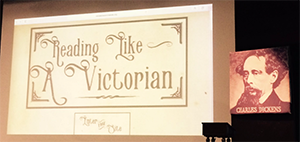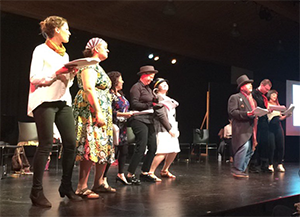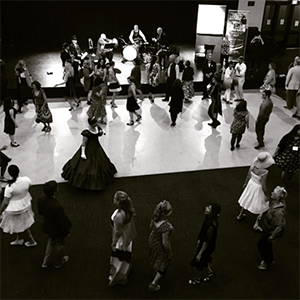A fine veil of smoke from the Soberanes Fire in the Los Padres National Forest to the south enveloped Santa Cruz during first day or two of the 2016 Dickens Universe, which was held Sunday, July 31, to Friday, August 5. The smoky haze didn’t deter the 256 attendees, which included 123 members of the general public, 114 faculty members and graduate students, and 19 undergraduates from high schools, community colleges, and other colleges. This diverse group gathered at College Eight on the UCSC Campus for the 36th annual conference to read and discuss Dombey and Son, which has been treated twice before by the conference, in 1987 and 2002.

Photo by Azucena Cortes
Graduate students and faculty arrived in Santa Cruz on Saturday, July 30, and they were joined on Sunday afternoon by community members, high school and community college teachers, undergraduate students, and Road Scholars (formerly Elderhostel). Registration, welcomes, reunions with old friends, and dinner in the airy College Eight Dining Hall segued into the first lecture on Sunday evening in the Porter Dining Hall, converted to an auditorium for the week. Director John Jordan welcomed what he called a “very handsome audience,” noting that although the conference is enjoying its largest faculty and grad student numbers ever this year, the members of the general public slightly outnumber them. Jordan introduced the new assistant director of the Dickens Project, Courtney Mahaney, who took over this spring when JoAnna Rottke retired. He also introduced Courtney’s assistant Azucena Cortes, conference organizers Jim Adams of Columbia University and Nancy Henry of the University of Tennessee Knoxville, and Dan Atwell, president of the Friends of the Dickens Project.
Jordan then introduced Andrew Miller of Johns Hopkins University, who spoke on “Dislodging Language.” Miller has been at Johns Hopkins only a year, having taught previously at Indiana University. He said he would speak not on a theme, but on the “form and shape of the novel as a whole, and how we should respond to that form.” Dombey and Son, he said, in the words of literary critic Steven Marcus, obeys the “pull of tidal power,” an image that was revisited throughout the week. But Miller’s talk veered from this trope to talk about what he called “the modern ideal of organic form—art as wholly integrated complex wholes,” which, he said was a “readerly task.” All of the anomalies in a novel mean something, and it is our task to figure it out. He filled in the background of this idea with a discussion of Charles Lamb’s criticism of Milton. Lamb bemoaned the fact that he was not an academic himself, but the idea of art appealed to him. Here, Miller said, was a “contingency”—the sense Lamb had that he could have been otherwise. Miller said that one of the things he looks for is “contingency” in literature—in this novel, for example, the idea that Dombey might have been someone else had things been different. There are in the novel, he said, “small pointless gifts” that readers are given over and over again. But, he said, “those moments then leave. You can take the gift, but not the experience of it. You remember the moment you read something, not the entire novel.” The title for Miller’s talk came from T.S. Eliot, and the entire phrase is “dislodging language into meaning.” Readers are more adept with meaning in Dickens, he said, than with this “dislodgement.” Might the Dickens Universe, he asked, be a “set of directions” with which we might study the novel?
After the evening lecture, the first part of the BBC film version of Dombey and Son from 1983 was shown; screenings continued throughout the week. In the morning, the general public enjoyed breakfast in the College Eight Dining Hall and then dispersed to 8:30 a.m. discussion groups led by teams of faculty members. These groups started out years ago as the “context” sessions, meaning that they were originally designed to offer attendees lessons on the historical background in which Dickens wrote his novels, as compared to the 11:15 graduate student-led sessions, which focused on the text itself. Now titled simply “Faculty-led Discussions” in the program, some of these morning groups adhere to the original model, and others focus on whatever participants wish to talk about. The group attended by this writer, led by Gerhard Joseph of CUNY and Daniel Stout of the University of Mississippi, covered 19th-century psychology, technology (including railroads), geology, social reform, philosophy, and realism vs. melodrama. The group also discussed several of the lectures and looked at a number of passages in the novel that were evidence of Victorian-era changes in these fields.
The Monday morning lecture was delivered by Project Director John Jordan of UCSC, who spoke on “Openings.” The word “Openings” has three meanings, Jordan said: a beginning, a vacancy to be filled, and a gap that allows access from one place to another. Narratives, he said, are riddled with gaps, and those gaps give Dombey and Son a “stop-and-start” rhythm. There are a number of openings in the form of vacancies created in the novel, starting with Fanny Dombey’s death, which leaves an opening to be filled, and continuing with the deaths of Paul, Walter, Carker, and others. Paul needs a mother, which is a vacancy. Florence needs a father, and a brother. The Midshipman needs an owner, and Mrs. MacStinger needs a lodger. Some of these openings are filled, and some are not. But there are also vacancies in the form of incomplete sentences filled in by someone else, another type of opening. The loss of the “Son and Heir” creates two openings: the “son” and the “heir” may not necessarily be the same person. Mrs. Skewton’s “senior moments” are openings in the form of “gaps,” and there are other openings in the Dombey mansion in the form of its windows and doors: the window in Paul’s room that serves as a way for Florence to view an alternate world, the door to her father’s room that serves as a boundary for her, and the front door, which represents freedom for her at the time she flees. Yet at the end, the opening created by Edith is never filled, creating, Jordan said, a “new opening for independent, strong women” in the fiction that followed.

Victorian tea
Photo by Heidi Renee Aijala
The assembly again broke into 11:15 graduate student-led workshops after the morning lecture. After lunch, the 1:30-3:00 slot was the most active, with a number of choices for people, including a repeat of the film screening, a high school teachers’ workshop, the Dickensian Seminar led by Rob Polhemus of Stanford, special field trips to various places on campus, and seminars for both undergraduate and graduate students. The Dickens Universe is an important resource for graduate students, who can attend not just seminars focusing on the novel, but who are assigned to workshops in “Active Listening” “Pedagogy,” “Publication,” “Writing,” and “Professionalization,” a session that covers journal publication, the job market, and dissertations.” Undergraduates are required to attend all major lectures and the 8:30 and 11:15 sections as well as the seminars in this time slot, and they are required to submit a 7- to 10-page paper to receive university credit. At 3:00, the Friends of the Dickens Project hosted their popular tea party Monday through Thursday, with hot Earl Grey tea served from silver teapots into china cups, homemade tea cookies, ginger tea punch, and fresh strawberries. This event is always well received by busy conference-goers looking for a mid-afternoon pick-me-up.
Each afternoon at 4:00, a “talk” is presented in the Porter Dining Hall. On Monday, Elisha Cohn of Cornell University focused on Diogenes in her talk “What the Dog Said: Inhuman Voices in Dombey and Son.” She was preceded by a special guest: UC President Janet Napolitano, accompanied by Chancellor George Blumenthal, visited the Universe at this juncture, making it her only stop on campus as she passed through Santa Cruz. She was introduced by John Jordan, who gave a short history of the Dickens Project, saying, “We owe our existence to the Office of the President.” When multi-campus research projects (MRUs) were proposed at UC, the Dickens Project was one of very few that were granted for the humanities; most were in the sciences. Napolitano was carrying her own copy of Dombey and Son, and she surprised and delighted attendees by giving them her own brief take on the novel, saying that when Mr. Morfin describes to Harriet and John how he learned about John’s past, he makes the comment that he believed everything was right all along because he was used to it. So how do things look when we have to look at them afresh? This, she said, is a way to look at the humanities, and she believes that they are a cornerstone of UC’s mission. “The Dickens Project plays an important role in this vision,” Napolitano said, and added that she is “thrilled” with the establishment of the Jordan-Stern Chair, a position currently held by John Jordan.
Other afternoon talks throughout the week included “The Railway Dragon,” by Thad Logan of Rice University; “Slavery and Marriage in Dombey and Son” by Lucy Sheehan of Columbia University; and a presentation on Thursday by Santa Cruz resident Liz Pollock, owner of The Cook’s Bookcase, an online bookstore featuring books, many of them antiquarian, on cooking. Her talk was titled, “In the Kitchen with Dombey: Exploring the Preparation of Food and Drink in the Victorian Kitchen.”

NAI representatives (left to right): Paul David Story, Jacqueline Barrios, Jon Varese, Kimberly Meija, Kenia Coyoy, and Mauricio Garcia
Photo courtesy of Paul David Story
Monday evening saw the first of the nightly Post-Prandial Potations, which allows attendees more time to chat with each other about the novel, the lectures, and other topics while they imbibe wine, beer, or soft drinks in the patio outside Porter Dining Hall. “PPP” was accompanied by a silent auction organized by the Friends of the Dickens Project and sales of antiquarian books by various sellers. Before the Monday evening lecture, Jordan announced the winners of the scholarship awards this year. High school scholarship winners, drawn from the NAI project at Foshay Learning Center in Los Angeles, were Mauricio Garcia, who has been accepted to Harvard, and Kimberly Mejia, Amber Johnston, and Georgia Delgado, all of whom will attend USC. Amber and Georgia were unable to attend the Universe; Mauricio and Kimberly were accompanied by teachers Jacqueline Barrios and Paul David Story of Foshay’s theater department. They were joined by alum Kenia Coyoy, a scholarship winner two years ago who is now a junior at USC. The California Community College scholarship winner was Erin Sandvold of College of the Redwoods, a student of longtime conference attendee Susan Nordlof. Congratulations to these students and to their instructors.
Monday evening’s lecture by Garrett Stewart of the University of Iowa, “Dealings with the Prose of Dombey and Son, Wholesale, Detail, and for Mass Circulation,” followed Andrew Miller’s “Dislodging Language” with another look at the “whole”sale of the novel from the point of view of what he called “acrobatic syntax” and its meaning. Miller, one of the founding faculty members of the Dickens Project, has not spoken at the Universe for decades, and this year he gave the Herb Furse Memorial Lecture, named for Friends of the Dickens Project founder Herb Furse of Chicago. Dickens’s “fissured grammatical efforts,” Stewart said, allow Miller’s “contingency” to meet organic form. His examples were numerous and wondrous, including Dickens’s many uses of syllepsis, the joining of disparate meanings to a single word: “stiff with starch and arrogance”; “she shook her head and a tin canister”; “into the great room came Susan Nipper and the candles.” In addition to these plays on words is Dickens’s “interstitial energy,” in Stewart’s words, evident in the interstices (or lack thereof?) between words, such as “Toots tumbled staggering out into the street” and “its way with sand.” Dickens also plays with tenses and moods, as in the narrator’s “Let him remember in that room, years to come” passage, where Dickens not only shifts to present tense but employs the imperative, optative, and hortative moods. Shifting antecedents to pronouns and alliterations are other features that, Stewart said, heighten the tension between Dickens’s discourse and his story. “This is not just literary prose,” Stewart said, “but language itself in operation.” He also touched on the scene where Rob the Grinder spells out “D.I.J.O.N.” on the table, erasing each letter before he writes the next. Does this, Stewart wondered, echo Dickens’s writing style? He closed by saying that the “deep structure of narrative grammar” is one way of “dealing with Dickens.”

Peter Capuano: "Digital Dombey"
Photo by Declan Kavanagh
Peter Capuano of the University of Nebraska, Lincoln delivered the Tuesday morning lecture, “Digital Dombey,” which continued the theme of finding new ways to read Dickens. Rather than looking to language for meaning or focusing on themes in the novel, Capuano enthralled his audience by discussing one phrase, “right-hand man,” not in its figurative sense, but in its quantitative sense. It is used seven times in Dombey and Son. One might wonder why the use of a phrase just seven times in a 900-page novel is significant, but that wasn’t Capuano’s point. The rise of the “Digital Humanities,” he said, allows analysis above and beyond what has been done before. Digital research methodology allows scholars to produce data that can then be mined for broader meaning. “Right-hand man” appears just seven times in Dombey and Son, but in a search of 250 19th-century novels by 100 British and Irish authors over 100 years, the term is used a total of 10 times. Three are in other authors’ work; in Dickens, the term is used seven times, and those seven uses are all in Dombey. Dickens uses the phrase nowhere else in his oeuvre, although, Capuano said, he does recycle other “bodily idioms.” Once the code to find such data has been written and the data have been mined, what does this tell us, on several levels? How are attitudes toward the body—and body parts—changing in the 19th century? What was idiomatically “normal” for writers in this era? Capuano’s program also searched novels and newspapers, and he sorted instances of the phrase into military, law, politics, business, and nautical usage. It seems to have started with sea-going folks, and then found its way into other areas; it rose in popularity in the press between 1820 and 1840. Capuano posits that Dickens’s friendship with retired British Royal Navy officer Frederick Marryat, also a novelist who wrote sea stories, may have had an effect on his use of the phrase. Capuano’s findings put him in a position to ask questions about the novel, and he explored ableness and disableness, the dichotomy of Cap’n Cuttle being a right-hand man with no right hand, the fact that Carker is referred to as Dombey’s right-hand man only after Paul’s death, and that there are, in fact, a number of right-hand women, not just men, in the story. Acknowledging the charges of “scientism” by “STEM-happy administrators,” Capuano said that the 1s and 0s he uses in his code are merely “the fingers we use to thumb through the Penguin edition.” Digital research will “facilitate a new way of seeing energies in a novel,” but, Capuano warned, the quantitative analysis afforded by this kind of research has its limits—it can damage human analysis. “We must close the circle with human interpretation,” he said, calling digital research methodology “exploratory rather than evidentiary.”

Claire Jarvis: "Edith's Two Bodies"
Photo by Nancy Henry
On Tuesday evening, Claire Jarvis of Stanford gave a lecture originally titled, “Edith Dombey, Mamma Dombey,” but she had changed the name to “Edith’s Two Bodies.” She was interested, she said, in “the strange work Edith does for Dickens.” She would reveal this, she said, by presenting an interpretation that came entirely from the novel, but she would add how she came to this interpretation, noting that interpretations can be shifted by personal experience, and that this had happened to her. Giving birth to her son Felix, six weeks old at the time of her lecture, gave her new insight into Edith’s character and into the story. Jarvis outlined her lecture in three parts: “Queenly Edith,” “Mamma Edith,” and the central adjustment that Edith makes at the end. In the larger scope of women characters in Victorian novels, Jarvis said, “Queenly Edith” is quite familiar. She is the dominant woman who provides a sexual lure without the “fallen woman” plot. Novelists of the era used such women often to criticize this lifestyle. So why are we meant to involve ourselves so deeply in Edith’s story in this novel? And why does Edith not “fall,” or die? Elsewhere in Dickens’s novels, such women do fall. In the end, Edith refuses “fallenness,” but the fact that Edith has had a child who has died accidentally is what initially promotes her to “Mamma Edith.” Jarvis pointed out that a number of mothers, both perfect and imperfect, take up large portions of the plot in the novel. There is, she said, a “structural resistance to the fallen woman plot” in Edith’s ability to embrace Florence from the very first. She is, Jarvis said, able to “hold onto motherhood past the loss of her own child.” In the third part of the lecture, Jarvis talked about “quickening” in pregnancy, which she related to the literary concept of “doubling,” or becoming two lives, hence the change in the title of her lecture. There is also a double in Alice, of course, but motherhood creates Edith’s two bodies: “one becomes two, and two become one,” Jarvis said. At the end, Edith is “singular, multiple, and alone.”

Ryan Fong: "Dombey and the Sea"
Photo by Tara Thomas
Ryan Fong of Kalamazoo College, whom John Jordan introduced as “the first third-generation faculty speaker,” by virtue of his having been a student of a student who was a student of an original Project faculty member, spoke on Wednesday morning. His lecture was titled “Dombey and the Sea.” He started by pointing out the common but truly misleading shorthand of the novel’s title. By truncating the title, he said, readers who assume that “Dombey and Son” refers to Paul and Paul Jr. miss entirely the distinct fact that Dickens meant it to refer not to the people but to the firm, the entire title being Dealings with the Firm of Dombey and Son, Wholesale, Retail, and for Exportation. But the sea in the novel, he said, restores the connection to not only the firm, but the world in which the firm operated—the British Empire, which was itself undergoing a time of conflict and breakdown. Although there is no detailed description of the sea itself in the novel, and all scenes that take place on the ocean are offstage, the ocean plays a key role. Not only does it define the world at the time, but it also describes death, starting with Fanny, who clings to the “spar” of her daughter, a metaphor repeated in Paul’s death scene. The destructive power of the ocean, Fong said, also measures the “erosion of bonds” in the Dombey family, taking Walter to Barbados, Edith to France, and, later, Walter and Florence to China. These trips also map the era’s change in the British Empire, leaving Barbados behind as England shunned slavery and its practice and opened new avenues of trade in Asia; Walter is, in fact, picked up by a China Trader, which foreshadows the way he eventually makes his fortune. The novel thus creates a “geological seascape,” Fong said, representing both global and family structures. Some interesting notes in Fong’s talk included the table at which Mr. Dombey sits and which Dickens refers to as a “dead sea of mahogany.” Mahogany furniture, made from wood originally harvested in Madeira, was a class marker at the time, but was harvested using slaves, which, Fong said, are represented in the “two exhausted negroes holding up two withered branches of candelabra on the sideboard” in the same scene. And, Fong added, Walter actually travels the path of the old Madeira kept for his return; the wine is a metaphor for the young man. Fong ended his lecture with a section titled “Forgetting the Native.” Joe Bagstock’s manservant is decidedly comic in this novel, but what of the racism that is obvious in this portrayal? Because it is not integrated into the oceanic forms (no one knows where the native calls home), Fong said he did not include it in his analysis, but he does feel that “those most acutely affected by imperialism are represented by the native,” and that the character may encourage us to look at the literature of forgotten nations.
Wednesday evening was a free evening, and participants were welcome to attend the Shakespeare production, which is no longer held in the theater in the glen on campus. Santa Cruz Shakespeare has moved to DeLaveaga Park, and many people, for whom the walk across campus to the glen was part of the attraction, did not attend, choosing to spend their Wednesday evening catching up on reading or resting. Those who did attend, however, said the production of A Midsummer Night’s Dream was worth the drive to the new venue.

Robyn Warhol's Victorian Serial Novels website
Photo by Miranda Butler
On Thursday morning, Robyn Warhol of the Ohio State University introduced the Universe to yet another research methodology in her lecture “Synchronic Serial Readings: The Case of Dombey and Son.” Warhol and graduate student Colleen Morrissey have put together a web site, victorianserialnovels.org, that allows readers to, as the site’s introductory page promises, “Read Like a Victorian.” Like Peter Capuano’s digital research, this work will allow researchers to look at all Victorian novels in the context of their serial publication and what the public was reading at the same time. It is, Warhol said, “a structure for reading that has changed my mind about the form of the Victorian novel.” Since the middle of the 20th century, academics have looked for patterns and then go from there to meanings, she said. Henry James, often vilified for calling Victorian novels “loose baggy monsters” may have been on the right track after all. From a cultural studies point of view, any serial form needs its gap; even modern television shows that employ cliffhangers from season to season require that time away from the story for viewers to digest and analyze. But what, Warhol asked, is the structure of that gap? Her website hopes to provide some of the answers. Reading serially is not easy to do with paper copies, but the web site makes it logistically easy not just to read a Dickens novel serially, complete with the ads included in the wrapper, but to read other novels that were being serialized at the same time. She and Morrissey, who assisted with presenting the lecture, have scoured Project Boz, Dickens Journals Online, the Victorian Web, Librivox, Project Gutenberg, the Hathi Trust, and other repositories of online texts to provide their users with links to periodical facsimiles wherever possible, as well as illustrations and audio recordings of the texts. Some works, she said, were difficult to locate in serial form, and others were difficult to work with because the eventual bound version of the novel differed radically from the serial version. Dickens, Warhol said, gave her the least trouble in this area. An example that she gave from one of the timelines is that at the time readers were receiving parts of Dombey and Son, Victorians would have been reading about other motherless girls trying to face the world, in Vanity Fair, Jane Eyre, and Evangeline. This juxtaposition “allows us to reconfigure our idea of what a Victorian novel is,” she concluded. The site is usable but under construction; stay tuned!

"Firm Dealings with Dombey" farce actors
Photo by Miranda Butler
For many years, Thursday evening at the Dickens Universe has been set aside for the production of a farce based on the year’s novel, and this year was no exception. Ably written and directed by playwright Adam Abraham, “Firm Dealings with Dombey—a Travesty” is set “in a university somewhere in America, time = the present.” The First Annual Jane Austen Universe is planning an evening of private theatricals and attendees are voting on their favorite novel. And the winner is...Dombey and Son, by “he who must not be named.” After some griping, the group agrees that they must perform whatever is selected, and they commence their farce. Dombey is married to Melania, who gives a heavily accented introductory speech and is joined on the stage by Paul, Polly Toodle, and the “long lean” Miss Tox, played by diminutive Sharon Weitzman. Little Paul is sent to Dr. Blimber’s academy, where genetic engineering is taught and Mrs. Blimber romances Cicero. His classmates are Little Nell, Tiny Tim, and Jo the crossing sweeper, and exams are given on such topics as Jacques Derrida on grammatology. The first song of the play, sung by the doomed young people to the tune of the Beach Boys’ “Wouldn’t It Be Nice,” contains lyrics such as “Wouldn’t it be nice to greet tomorrow, rather than the silence of the tomb?” Gills and Cuttle appear and hug each other; they adopt a child, Gay Walter. Miss Tox appears again to sing (and dance) “If I Were a Dombey, yubby dibby dibby dibby dibby dibby dibby dum,” to the tune of, well, you know. “Would it spoil some Dick-ens Universe...if I were a Dom-bey wife?” Major Bagstock, resplendent in glittered purple vest, tries Dombey out on several women before settling on Edith, and Bagstock and Cleopatra plan the wedding. The Right-Hand Man appears along with a projected ad for Tooth-Pulling Paste. A railway trip is planned, “the only way to travel!” Edith fumbles her lines and starts to giggle, but the young grad student portraying her is so impressive, in her tiara, black leggings, and heeled boots, that no one seems to care. More lyrics: “I could write a bad romance...let’s take the train to France.” Everyone is invited to tea in the veranda. A scene between Cap’n Cuttle and Florence is menaced in the background by a ghostly figure under a bed sheet, which turns out to be Gay Walter, returned from his travels. In the finale, Dombey comes out to the world, singing, “Wives may come and wives may go,” wrapped in a purple feather boa.

Photo by Azucena Cortes
Kudos to the cast and crew. It is always amazing that this project is started on Sunday night with a call for volunteers, “and is there anyone here who can play the piano?,” and that it culminates in a cohesive production four short days later. The cast gives up their teatime from 3:00 each afternoon to rehearse, and the result is remarkable. Immediately following the farce, all attendees were treated to the annual “Grand Party” in the College Eight Red Room below the dining hall. This event, sponsored by the Friends of the Dickens Project, offers a lavish and beautifully presented spread of cheeses, crackers, fruit, cakes, wine, soft drinks, and beer, and is always well attended and well received, especially as everyone is in high spirits already following the farce.
The final lecture of the conference was delivered Friday morning by John Bowen of the University of York and was titled “Zombie and Son.” “It’s not really about zombies,” Bowen apologized at the start, but about the relation of the living to the dead, and about states of being between living and dead. Paul Jr. feels his mother’s death the whole of his truncated life; Cleopatra is half in and out of her present life, confused with her younger self; and Cap’n Cuttle lives a life of half-remembered phrases and rituals. Bowen returned to the theme of hands in the novel, pointing out the seeming disassociation from the rest of the body in their gestures: Cap’n Cuttle uses gesture as memory, tracing words in the air with his hook. Dombey and Son is also a novel about living on after great loss and is full of injunctions to remember, Bowen said. There are, too, the Dickens hallmark of quotations and quotability. Gamp, Micawber, Dick Swiveller, “are all great quoters and misquoters,” he said, “but Cap’n Cuttle is supreme in this group.” The second part of Bowen’s paper was, in fact, titled “Zombies,” and here he identifies them. The Midshipman is “a ghost of a business.” Mrs. Blimber is enamored of a dead man. Toots, he said, is “an amiable zombie.” Young Paul is like an old man, not human at all. And religion, the third section of Bowen’s paper, also enters the mix. Although it would seem to be absent from the novel itself, Dickens “draws on Christian language and tropes, but in different ways,” Bowen said. The characters stand fast against death; Cap’n Cuttle admonishes his listeners to “overhaul” the catechism. The captain, Bowen said, is not usually a favorite of critics, “but I love him.” In the final section of the lecture, Bowen focused on ceremonies—birth, christening, death, marriage. But there are other, less formal ceremonies in the novel, including the captain’s reading of the burial service in memory of Walter, “one quasi dead man mourning another,” he said. “It’s not just the catechism that’s being overhauled, and not just by Cuttle,” Bowen said in closing. The novel is, in the words of Bowen and his beloved Cuttle, “perfectly ‘unformiliar’ as a zombie.”

Victorian Dance
Photo by Azucena Cortes
After an abbreviated day on Friday, the Universe closed with the last Post-Prandial Potations gathering; the major auction, with Friends of the Dickens Project President Dan Atwell at the gavel; the announcement of next year’s novel; and the Victorian Dance, led this year by longtime Universe attendee Annie Laskey of Santa Cruz, with music provided by the Brassworks Band. Laskey offered dance instruction Monday through Thursday afternoons this year just before dinner, and the practice was evident Friday evening. Auction takings for the week, including the daily silent auctions and the Friday evening live auction were in the $8,000 range. This money, earned thanks to generous donors of auction items and generous bidders, goes into the Friends of the Dickens Project treasury to support future Universe speakers and performers.
The book for next year is George Eliot’s Middlemarch, published in 1874, four years after Dickens’s death. In announcing the choice, John Jordan called Eliot “the second best writer of the period.” Although this non-Dickensian choice has already met with some resistance from diehard Dickens fans, this writer looks forward to reading and discussing the novel, believing that it will add an important facet to understanding the Victorian context. In addition to analysis of the relationships and events in the town of Middlemarch, the anticipation is that presentations will touch on how Dickens influenced Eliot, and how her novel corresponds to Dickens’s body of work. Next year’s conference is scheduled for July 30-August 4; registration opens at the end of the year.
Beth Penney
August, 2016

